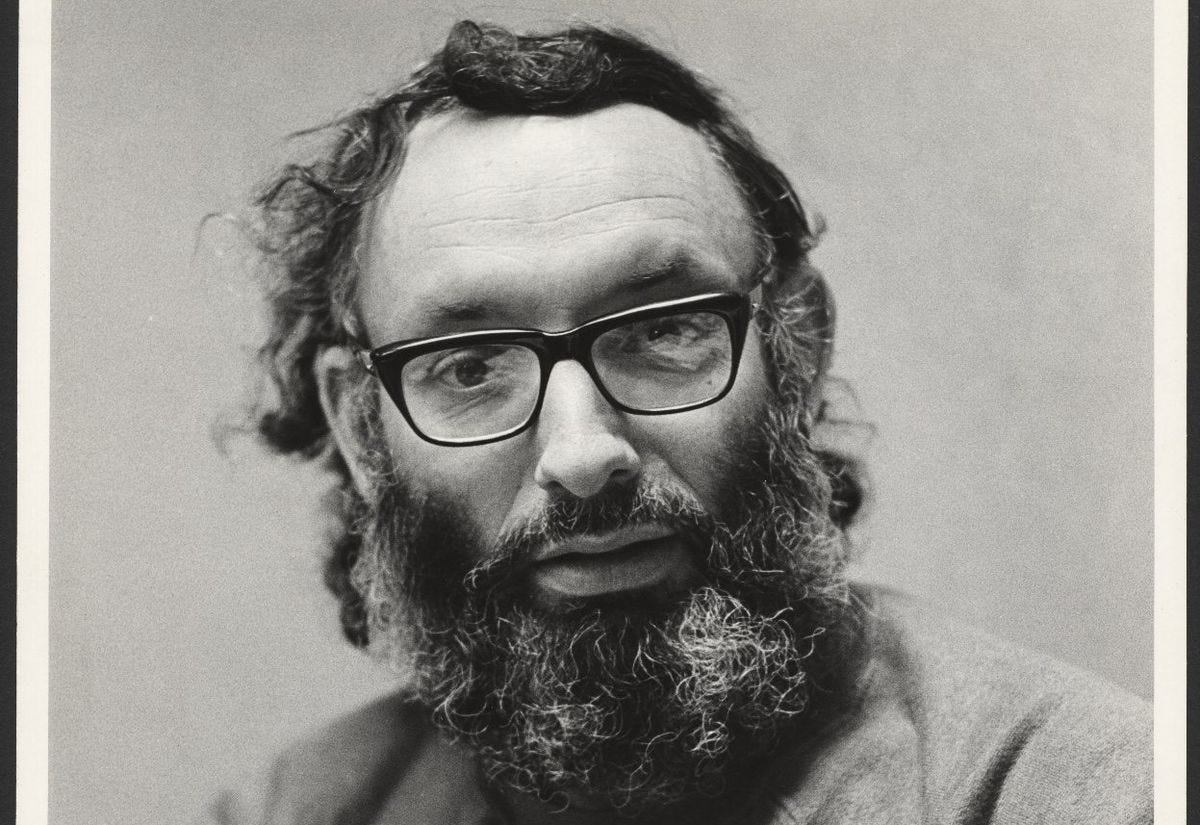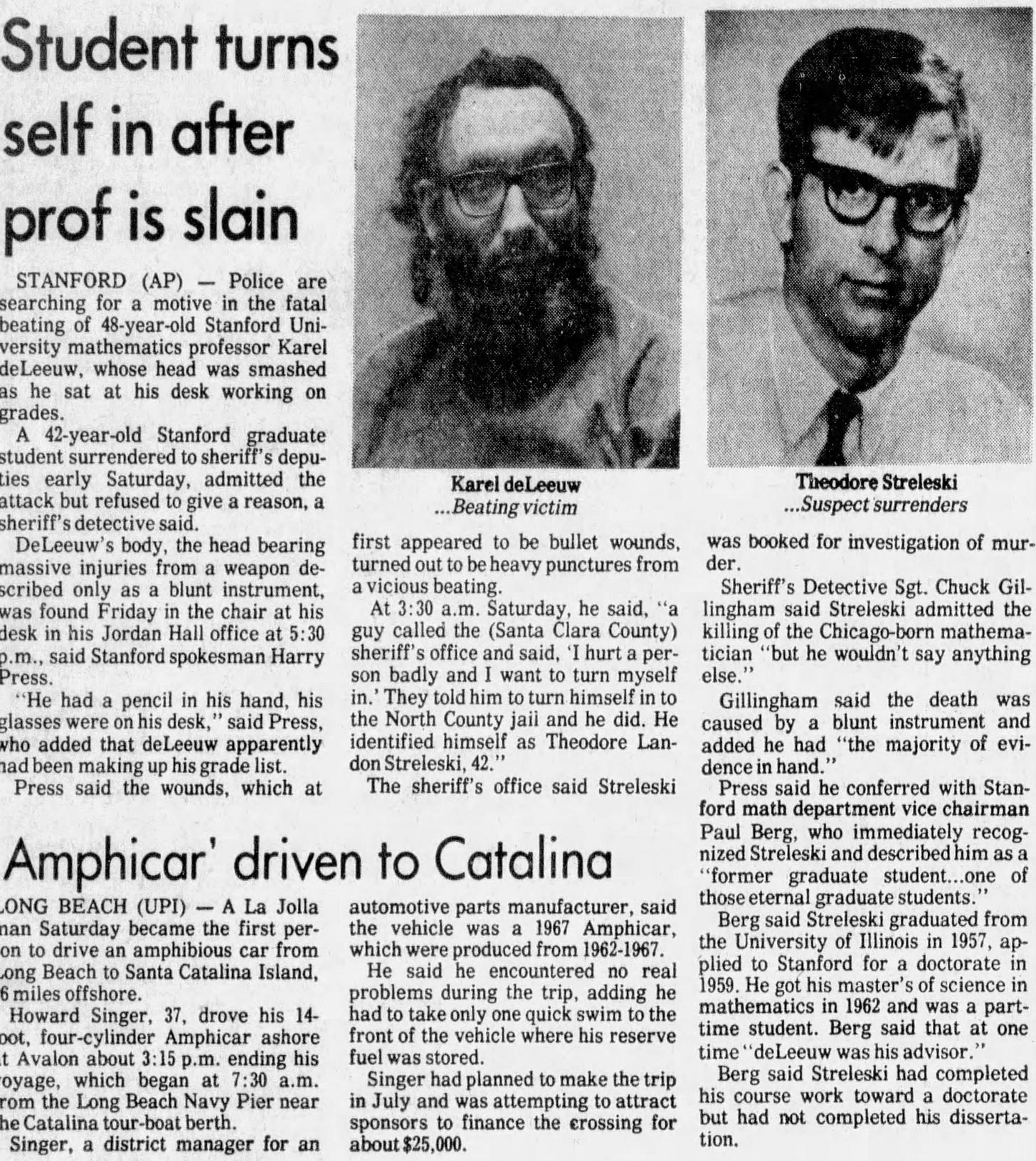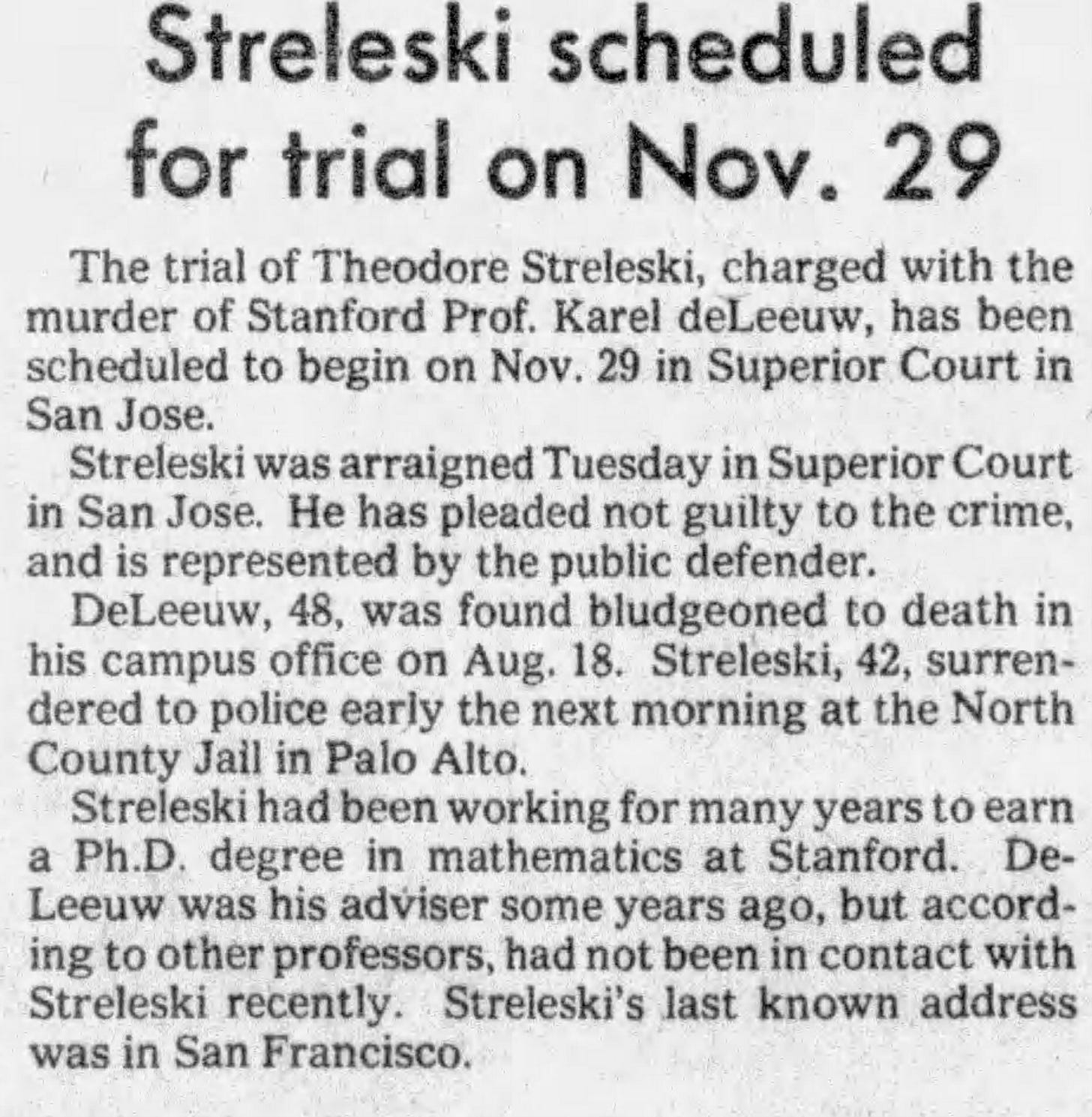A Deadly Grievance: The Troubling Tale of Theodore Streleski
In August 1978, a troubled and struggling Stanford grad student named Theodore Streleski bludgeoned a highly regarded professor to death in what he called an act of "protest"
Background
Around 8 a.m. on a misty September morning in 1985, reporters and photographers stood by, awaiting their chance to ask questions to an unrepentant killer. 49-year-old Theodore Streleski had been released from prison after serving just over seven years for a second-degree murder conviction.
As Streleski fielded questions at the impromptu press conference, his answers were less than reassuring. When asked about the possibility of killing again, Streleski said, “I have no intention of killing again.” However, he then followed up with, “I can’t predict the future. I murdered before.”
When asked if he was remorseful, Streleski replied, “I have never felt remorse. I killed the man, and I submitted the issue to a judge and jury.”
Theodore Streleski
Born in 1936 in Breese, Illinois, Theodore Streleski was a bright student. Entering college at just 16, he earned an undergraduate degree in engineering from the University of Illinois.
He was disappointed after being rejected by both Harvard and M.I.T. for graduate studies. But in 1959, he was accepted by Stanford University.
There, he would spend the next 19 years off and on attempting unsuccessfully to complete his doctoral dissertation in mathematics. As his frustration grew, he began to develop a persecution complex.
He was angry that he had not received a scholarship and was forced to take on several low-wage jobs to support himself.
Karel deLeeuw
Six years older than Streleski, Karel deLeeuw was also born and raised in Illinois. He earned a B.S. in mathematics from the University of Chicago. He obtained his Ph.D. from Princeton University.
He took a position teaching mathematics at Dartmouth College before moving on to the University of Wisconsin and later joining the Stanford faculty. He also became a member of the American Mathematical Society.
deLeeuw would become Theodore Streleski’s academic advisor for a brief time and, tragically, the victim of his misplaced rage.
Time at Stanford
Streleski’s time at Stanford started promisingly. Three years after his arrival, he earned his master’s degree in electrical engineering. However, the problems started for Streleski when he began his Ph.D. studies.
He would try unsuccessfully for the next 16 years to earn it. He submitted several revised thesis papers that were ultimately rejected for publication. During these years, Streleski’s wife recalled that he changed and became a “different person.”
She cited instances of physical and mental abuse, which, on one occasion, required a hospital visit. By 1974, she had left him. Their divorce was finalized in 1978.
Streleski claims that while attempting to obtain his doctorate, Prof. deLeuuw repeatedly belittled him and made numerous biting and insensitive remarks at Streleski’s expense. During one meeting, he claimed that deLeuuw called him a “schoolboy” after Streleski had come to him for help.
These slights, real or perceived, were taking a toll on Streleski’s emotional health. By the late 1960s, Streleski began questioning whether he would ever acquire his Ph.D.
Burning Resentment
As the years went by, Streleski’s bitterness became a burning resentment. He came to believe that the university itself “cheated” its students. He would later claim that the murder of Prof. deLeeuw was “a rational act to dramatize Stanford’s abuse of its graduate students.”
He felt that the university was all too willing to take the student’s tuition money, while remaining indifferent to whether or not they graduate.
He would later say, ”Stanford appeared only to care if you paid them money,” they didn`t care if you passed the course or even attended it.”
By 1978, Streleski’s paranoia and rage were focused on one man, Prof. Karel deLeeuw. By then, deLeeuw was the assistant chairman of the university’s mathematics department.
1978 Murder
On the morning of August 18, 1978, Streleski traveled from his San Francisco apartment to the Stanford campus with a two-pound ball peen hammer concealed in a travel bag.
He entered the mathematics department and waited for Prof. deLeeuw. When the professor arrived and entered his office, Stresleski followed him inside. In a 1985 interview with People Magazine, Streleski recalled the murder:
"I walked up directly behind him. I hit him squarely on the top of the head with the hammer and then administered two or three of what I call 'insurance blows' to the right of the temple. There was nothing violent to the action at all. He rolled back to the storage cabinet in a rather graceful motion. At some point I heard what I assume was a death rattle. I covered him with a clean garbage bag like a shroud to save the feelings of the janitor who would probably find him." (By Dianna Waggoner - People.com)
Early the following morning, around 3:20 a.m., Streleski turned himself into the Santa Clara County jail in Palo Alto. He admitted to attacking Prof. deLeeuw but refused to say why.
Trial and Sentencing
In March 1979, Streleski stood trial for the murder of Prof. Karel deLeeuw. He dismissed his attorney’s advice that he plead not guilty by reason of insanity. However, a psychiatrist for the defense diagnosed him as a “paranoid psychotic.”
Indeed, Streleski showed no remorse for the brutal slaying. In his mind, he was completely justified. Rather than take accountability for his own choices and actions, he maintained that he was the one who had been wronged.
Streleski would later say, “Stanford took 19 years of my life with impunity, and I decided I would not let that pass.”
Streleski admitted he had considered other alternatives to air out his grievance, but he ultimately concluded that a high-profile murder was the only way to get the press coverage he desired.
He stated, "I realized that I had no leverage; television and the media don't cover struggling graduate students. But they do cover murderers."
Streleski also admitted that he had a short list of other potential victims should he be unable to attack Prof. deLeeuw. Never once did Streleski express remorse for what he had done. However, his attorney was able to convince the jury of Streleski’s “diminished capacity” while committing the murder.
The jury found Streleski guilty of second-degree murder. He was given a sentence of seven years, the maximum allowed at the time under California law. He was also given an additional year for using a dangerous weapon.
Parole Refusals and Release
Amazingly, as light as Streleski’s sentence was considering what he had done, he had several opportunities to be released from prison even earlier than he was. In March of 1984, he was paroled but immediately reincarcerated for refusing to sign documents detailing his parole conditions.
He was again eligible for parole twice after that, and each time, he refused to sign any papers that would have given him a conditional release. Instead, Streleski maxed out his sentence and was granted his unconditional release from prison in September 1985.
Following his release, Streleski did several interviews and, for a brief time, basked in the attention he had sought.
In October 1985, less than a month after Streleski’s release, Karel deLeeuw’s widow did an interview with the Los Angeles Times in an attempt to balance the seeming one-sided coverage of the story by the media.
During the interview, she said:
“I want to remain silent as well. But after a few days of hearing Streleski tell his story unchallenged, I felt the need to respond to reporters' inquiries in an effort to inject a dimension that was being forgotten into the story that I didn't want people to forget. I wanted people to know that whether Streleski was crazy or sane, whether his grievances were legitimate or not, a good man died on Aug. 18, 1978.” (Los Angeles Times, October 5, 1985)
Sources:
“Theodore STRELESKI.” Murderpedia, https://murderpedia.org/male.S/s/streleski-theodore.htm
Taylor, Ronald B. “Professor’s Murderer, Still Unrepentant, Is Free Man.” Los Angeles Times, 9 September 1985, https://www.latimes.com/archives/la-xpm-1985-09-09-mn-6892-story.html
“PROFESSOR`S KILLER FREE, NOT SORRY.” Chicago Tribune, 9 September 1985, (Updated 9 August 2021) https://www.chicagotribune.com/1985/09/09/professors-killer-free-not-sorry/
“Theodore Streleski, the Stanford University graduate student who killed...” UPI Archives, 7 September 1984, https://www.upi.com/Archives/1984/09/07/Theodore-Streleski-the-Stanford-University-graduate-student-who-killed/7067463377600/
“1985 - WKBW Eyewitness News Nightcast (September 8, 1985)” Uploaded by RetroTy: The Pulse of Nostalgia, 28 February 2015, https://www.youtube.com/watch?v=DMBYqcoEWxk&t=168s













7 years for calculated murder with an additional year for a dangerous weapon which isn't inherently a dangerous weapon decades ago boggles the mind and adds to the preposterous that is California and the criminal justice system